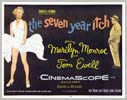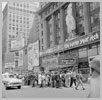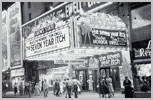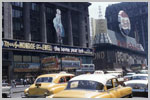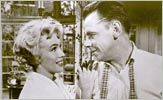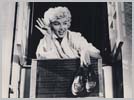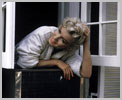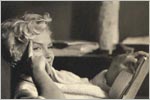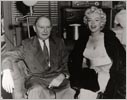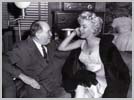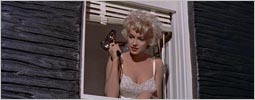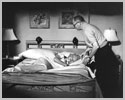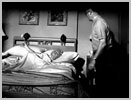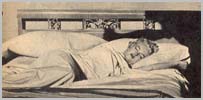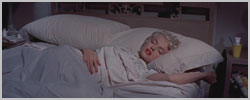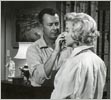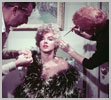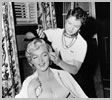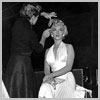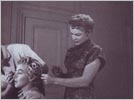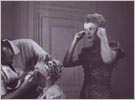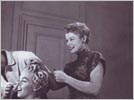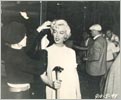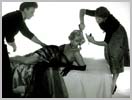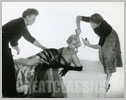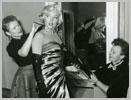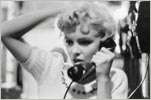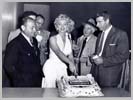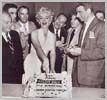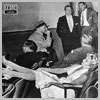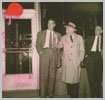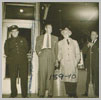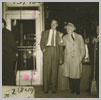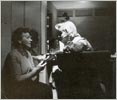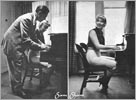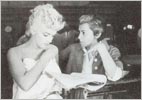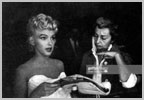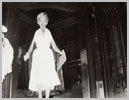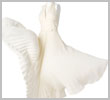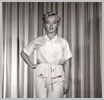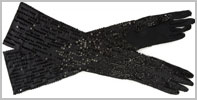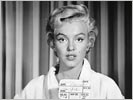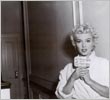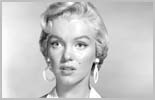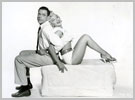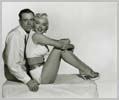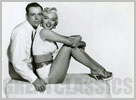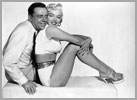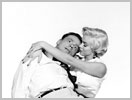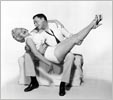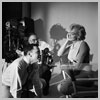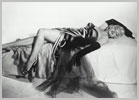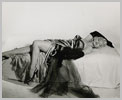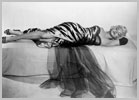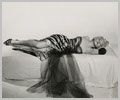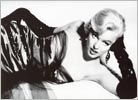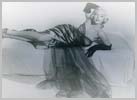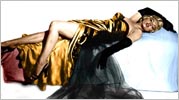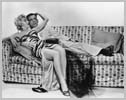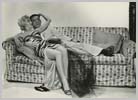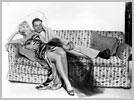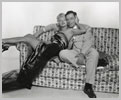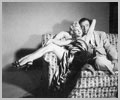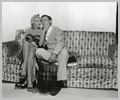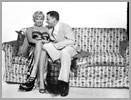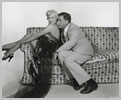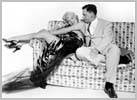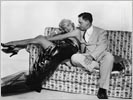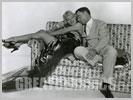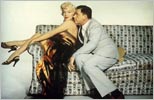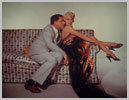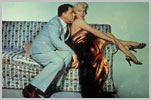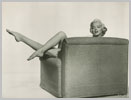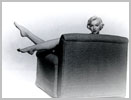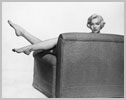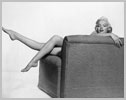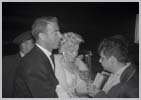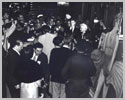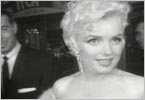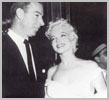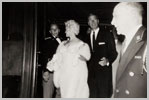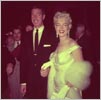
My journey ends here...
The Seven Year Itch (1955)
"The Seven Year Itch" was the last movie Marilyn shot for the Fox under the "ancien régime" - very restrictive contract and pitiful salary (to the Hollywood standards).
It was a long time she had spotted the qualities of this play, which had obtained a big success in Broadway.
Marilyn even agreed to play in a less attractive movie même de jouer dans un film moins attrayant, "There's No Business Like Show Business" (1954), on condition that the Fox purchase the rights of the George
Axelrod play, for the amount of 500 000$.
The shooting of "There's No Business Like Show Business" having got behind, she had to directly move on to "The Seven Year Iitch", on August 10, 1954.
Billy Wilder and Axelrod had then completely rewritten the screenplay and changed the end. In the stage version, the charcters became lovers but at the end of the movie, the virtue wins.
Tom Ewell, who had played the part on stage in Broadway, embodied a New Yorker whose imagination is fired during a long and hot summer , while his wife and little son are on vacation. The outbreak of his new neighbor who lives above, a fleshy blonde, upsets his world.
This character, played by Marilyn, is the queen of the ingenues : she put her underwear in the fridge to get some coolness, recognizes classical music because "there are no singing" and manages to give off a mischievous charm without even realizing the effect she creates.
Oddly, in the movie,Marilyn's character has no
name. She's only credited "the Girl". Here is what George Axelrod
answered when he was asked what did this mean : "The fact is that I
haven't ever found a name which suited her, a name which really fits
the girl I had in mind".
In this movie, Marilyn wears 10 different outfits. Fashion designer William Travilla finished in a week all his preliminary sketchs, including the one of the "aerodynamic" outfit which is, from then on, so closely linked to Marilyn's image : an ecru loose-fitting summer dress, all pleated, open back. As for many costumes, more than one specimen of this dress was made - one of them was exhibited at the Debbie Reynolds Museum in Las Vegas; another one belonged to the Anna Strasberg's legacy, and was auctionned in October 1999.
The production overran the budget of 10%, with a little less than 2 millions $, but it brought in minimum of 4 timesthis amount when it was released, beating all the other movies this summer.
In New York, for the outdoor sequences, it was the matter to promote the movie as much as shot it. The arriving of Marilyn in Big Apple was an incredible media event, with press conferences and times interviews. The press agents revealed to the reporters some sequences, and on September 15, 1954, guardrails were set up in front of the Trans-Lux Theater, at the corner of Lexington Avenue and 52nd Street.
Around 1.00 AM, while the shooting was about to start, several hundred of photographers fell over each other
to take
their place among a crowd of at least 5 000 viewers (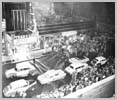 ) (according to Billy
Wilders' estimate, but a newspaper propunded the number of about one
thousand), who let out hurrahs each time (there were 15 shoots)
Marilyn's skirt blew out : with the draft made by a huge ventilator set
up under a subway
) (according to Billy
Wilders' estimate, but a newspaper propunded the number of about one
thousand), who let out hurrahs each time (there were 15 shoots)
Marilyn's skirt blew out : with the draft made by a huge ventilator set
up under a subway
railing, the dress revealed her legs and her white
panties  .
.
The shooting of this scene (became mythical) caused several consequences. First, none of the shots was usable : there were too much noise, not enough freely movements because of the crowd, and the used ventilator didn't produce the wanted effect.
In the final scene, shot in studion at the Fox, Marilyn walks on a railing, her skirt blows just above her knees and a link shot shows her face which expresses the pleasure of a cool breeze in a hot summer night. It's just an innocent reflection of the racy pictures taken by the hordes of photographers this night in Lexington Avenue, and yet, one of the three plans of the original sequence had to be cut to satisfy the "Hays code", purely delimiting what is appropriate on screen. The scene of the blowing skirt, maybe the most famous of Marilyn's career, is the archetype of glamor of the 50's, and that's the reason why it appeared in a way or in another for years in many movies, as in "Tommy" (1975), "Insignificance" (1985) and"Pulp Fiction" (1994).
The shooting also took place in a typical New York brownstone located 164 East 61st Street
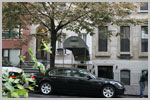 ,
, ,
, ,
, ,
, ,
, ,
,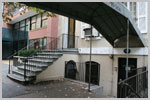 ,
,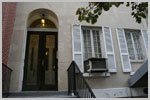 ,
,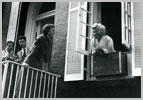 ,
,
But, at that time, the main repercussion to Marilyn was a Joe DiMaggio's fit of jealousy. Maybe pertinently knowing he was wrong, he had agreed that his friend, the reporter Walter Winchell, took him on the place of the shooting. He couldn't put up with seeing thousands of people leering at her wife for hours. Back to the St Regis Hotel, they had a violent argument. Three weeks later, the Fox published a statement announcing Marilyn and Joe's break-up.
Marilyn shot the last scenes on January 9, 1955, while she was officially suspended by the Fox,because she had left studio and set up her own production company.
After a 7-year
The premiere of the movie, on June 1, 1955, was a real gala spangled with movie stars. To mark the event,Loew's State Theater in Time Square received a poster, 16 meters high, representing Marilyn with an hiked up skirt, for the amout of around 1 500$.
Because of complaints, the original had to be replaced with a less provocative image.
Joe DiMaggio accompanied Marilyn at the theater (she asserted the reporters : "We are just good friends", but it didn't prevent her from the speculation of the prss about their reconciliation), where Grace Kelly, Henry Fonda, Margaret Truman, Eddie Fisher, Judy Holliday and Richard Rodgers, among others, attended the showing.
The movie was the biggest summer success, generating a groos takings of about 5 millions $ and reaching 6 to 15 millions $ at the end of the first release, according to several informations. As always, Marilyn had to wait to get her 100 000$ bonus from the Fox, while the studio and the co-producers, Wilder and Charles Feldman (who was hitherto Marilyn's agent), reaped much more money.
Production
Nightgown  ,
, (more pics here).
(more pics here).
Pink blouse
 ,
, ,
, (more pics here).
(more pics here). Costume Mae West
 ,
,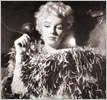 ,
, ,
,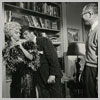 (more pics here).
(more pics here).White top and shorts
 ,
,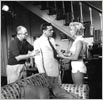 ,
, (more pics here).
(more pics here). Toothpaste advert  ,
,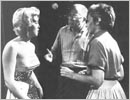 (more pics here).
(more pics here).
Dotted dress
 ,
, ,
,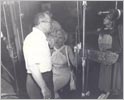 (more pics here).
(more pics here).White dress
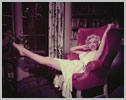 ,
,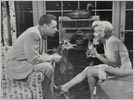 (motre pics here).
(motre pics here). Spotted dress  ,
, ,
,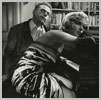 (more pics here).
(more pics here).
Strapped dress  ,
, ,
, (more pics here).
(more pics here).
Skirt scene  ,
,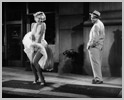 ,
, (more pics here).
(more pics here).
Bathtub scene 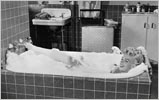 ,
, (more pics here).
(more pics here).
 (more pics here).
(more pics here).
 -
- ,
, -
- ,
, -
- ;
; ;
; ,
, ;
;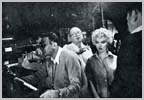 ;
;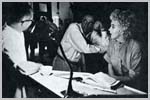 ,
, ;
;
With Whitey Snyder
With Gladys Rasmussen
Off set
short sleeves sweater, flowery collar
with DiMaggio and Walter Winchell
others
Wardrobe
Hairdressing
Publicity pictures
white top and shorts
spotted dress
alone
with Tom Ewell
Premiere of the movie, on June 1, 1955
CREDIT
Twentieth Century-Fox, Cinemascope and color (DeLuxe)
Runtime : 105 mn.
Release date : June 3, 1955.
Director : Billy Wilder
Producers
: Charles K. Feldman, Billy Wilder
Screenplay
: Billy Wilder et George Axelrod; George Axelrod (original play)
Director of photography : Milton R. Krasner
Music : Alfred Newman, Sergueï Rachmaninov
Costumes : William Travilla
Film editing :
Hugh S. Fowler.
CAST
Marilyn Monroe - the Girl
Tom Ewell -
Richard Sherman
Evelyn
Keyes - Helen Sherman
Sonny Tufts - Tom MacKenzie
Robert
Strauss - Mr Kruhulik, janitor
Oskar
Homolka - Dr Brubaker
Marguerite Chapman - Miss Morris, secretary
Victor
Moore - plumber
Roxanne - Elaine
Donald Mac
Bride - Mr Brady
Carolyn
Jones - Miss Finch
Butch
Bernard - Ricky Sherman
Doro Merande - waitress at vegetarian restaurantn
Dorothy Ford - Indian girl.
CAST (uncredited)
Ron Nyman - Indian
Ralph Sanford - train station gateman
Mary Young - woman in train station.
TECHNICAL CREW
Saul Bass - title designer
George W. Davis - art direction
Leonard Doss - color consultant
Doane Harrison - associate producer
Ray Kellogg - special effects
Charles Lemaire - wardrobe director
Harry M.
Leonard - sound
Ben Nye - makeup artist
Edward B.
Powell - orchestrator
Stuart A. Reiss - set decoration
Joseph E. Richards - assistant director
Walter M. Scott - set decoration
Allan "Whitey" Snyder - makeup artist : Miss Monroe, uncredited
Helen
Turpin - hair stylist
E. Clayton
Ward - sound
Lyle R. Wheeler - art direction artistique
Saul Wurtzel - unit production manager : New York, uncredited.
SYNOPSIS
After a 7-year wedding, New Yorker Richard Sherman (Tom Ewell) sends his wife Helen (Evelyn Keyes) and their boy Ricky (Butch Bernard) on summer vacation in the country.
The atmosphere considerably warms up when he discovers that the apartment above has been rented to "the Girl" embodied by Marilyn, a model who makes TV adverts for a toothpaste and whose naivety is only compared with her charm. It seems impossible to avoid "the Girl" : Sherman makes her come in the building the day she's locked outside; when by accident, she drops a tomatoes pot from her balcony, missing to kill him, his only reaction is to invite her for a drink at his home. His fantasy takes him back while he evokes in himself the different ways to court her. Shortly after the girl has confided him she felt secure with the married men, he tries to kiss her while they're playing "Chopesticks", and just manages to knock down the piano stool. Despite his humiliation, he can't stop thinking of her.
He imagines the consequences of his action if she would talk to people about his missing seduction attempt, and starts to imagine his wife bitting back by having an affair with his worst enemy, a certain Tom MacKenzie (Sonny Tufts).
Sherman finds the courage to invite the girl for dinner and to movie theater - it's when they are leaving the cinema that the scene where she's refreshing herself above a subway railing happens, in a cheerful draft.
This time, Sherman doesn't need any little scheme to get his kiss : she demonstrates him how her breath is fresh by giving him a big kiss.
Back to his apartment, she's so happy that he has the air-conditioner, she invites herself for the night. Sherman sleeps on the couch, and his paranoiac imagination bursts - maybe everything is just a conspiracy of the girl and the janitor Kruhulik (Robert Strauss) to blackmail him?
The next morning Sherman - enmeshed in his various
fantasies and plagued by doubts about his seductive power - is visited
by Tom MacKenzie, to who Helen has asked to go and take a
game forgotten by his son. Sherman's jealousy, nourrished by his recent
imaginations, bursts and he gives, ex abrupto, a punch
to MacKenzie, stunned.
Finally, Sherman realizes thta his place is besides his wife and
little boy he joins, offering the girl to take care of the
air-conditionned apartment during his absence.
AWARD
Golden Globe Award
- Best Motion Picture Actor - Musical/Comedy : Tom Ewell.
NOMINATION
At the British Academy Awards :
- Best Foreign Actress : Marilyn Monroe.
Exhibitor Laurel Awards

